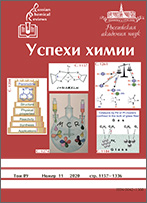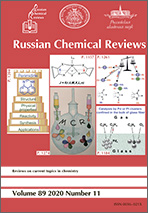|
Эта публикация цитируется в 13 научных статьях (всего в 13 статьях)
Perimidines: a unique $\pi$-amphoteric heteroaromatic system
Alexander F. Pozharskiia, Anna V. Gulevskayaa, Rosa M. Claramuntb, Ibon Alkortac, José Elgueroc
a Department of Organic Chemistry, Southern Federal University
b Departamento de Química Orgánica y Bio-Orgánica, Facultad de Ciencias, UNED, Spain
c Instituto de Química Médica, CSIC, Spain

Аннотация:
Data on the physicochemical characteristics, theoretical calculations, reactivity and synthetic methods for perimidines are summarized. Although perimidine and some of its simple 2-substituted derivatives were obtained by Sachs back in 1909, their chemistry and key physical properties remained unknown until the early 1970s. Subsequent studies revealed many fundamental features of the perimidine system, previously not encountered in the heterocyclic series. The first comprehensive review on perimidines was published forty years ago. The period that has passed since 1980 led to the emergence of new directions and trends. Several hundred new publications have appeared, the generalization of which has become the main purpose of this article. This primarily concerns the obtaining of highly nucleophilic and stable perimidine carbenes, new methods of electrophilic substitution and oxidation, establishment of a close relationship between perimidines and proton sponges, and modern theoretical calculations. Based on perimidines, many different polycondensed systems have been obtained. Applied research has developed especially rapidly in recent years. Many new compounds based on perimidines related to chemosensors, analytical reagents, dyes, metal catalysts, electronic devices, nanotechnology, and medical chemistry have been proposed. Some information under review is presented as Supplementary Materials. It contains six tables, which include data on the basicity constants of perimidines, details of some synthetic methods for perimidines and fused analogs and also a list of biological activities of perimidines. Bibliography — 379 references.
Ключевые слова:
perimidines, dihydroperimidines, perimidin-2(3H)-ones, perimidin-2(3H)-thiones, 1,8-diaminonaphthalenes, proton sponges, aromaticity, π-amphoteric properties, basicity, tautomerism, reactivity, synthesis, N-heterocyclic carbenes.
Поступила в редакцию: 14.05.2020
Образец цитирования:
Alexander F. Pozharskii, Anna V. Gulevskaya, Rosa M. Claramunt, Ibon Alkorta, José Elguero, “Perimidines: a unique $\pi$-amphoteric heteroaromatic system”, Усп. хим., 89:11 (2020), 1204–1260; Russian Chem. Reviews, 89:11 (2020), 1204–1260
Образцы ссылок на эту страницу:
https://www.mathnet.ru/rus/rcr4317 https://www.mathnet.ru/rus/rcr/v89/i11/p1204
|


|






 Обратная связь:
Обратная связь: Пользовательское соглашение
Пользовательское соглашение
 Регистрация посетителей портала
Регистрация посетителей портала Логотипы
Логотипы








 Цитирование в формате
Цитирование в формате 
